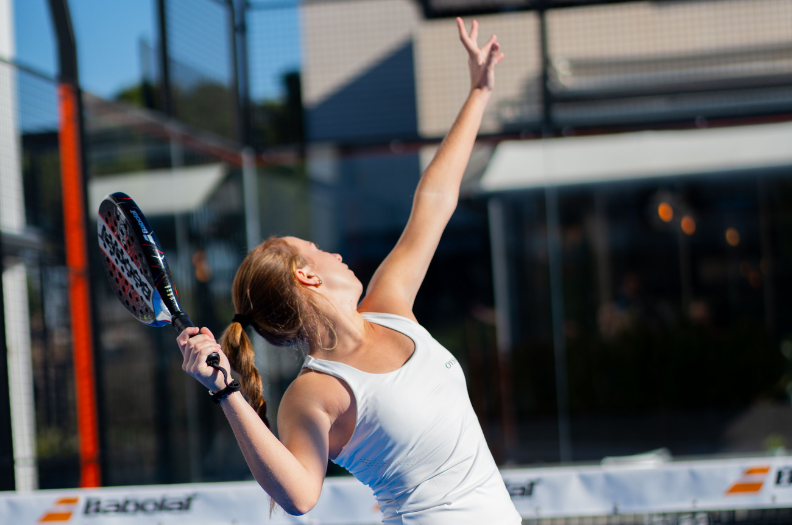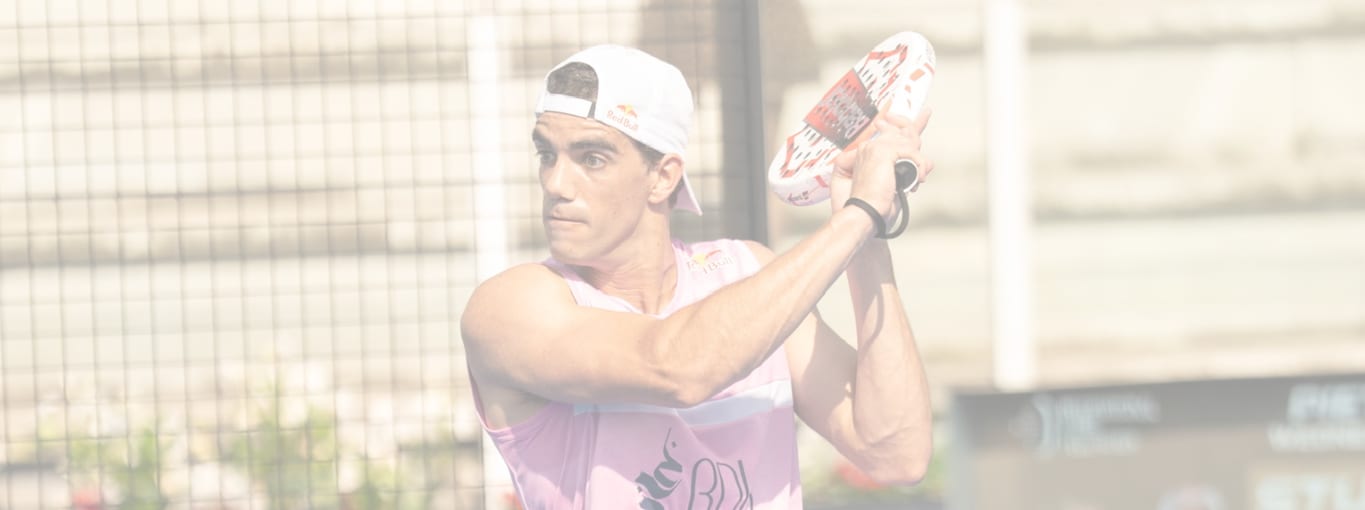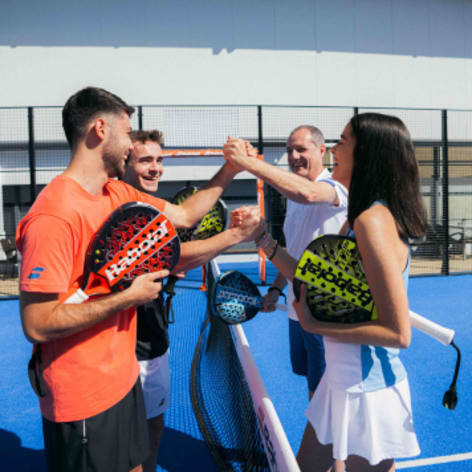Are you new to padel or looking to improve your game? Knowing the main padel shots is the first step to progressing quickly on the court. Halfway between tennis and squash, padel has its own techniques and signature shots that make all the difference in a match. Whether you play for fun or in competition, each shot has its purpose and ideal moment of execution. In this guide, we’ll go through all the essential shots—from the basics to advanced techniques—to help you build a complete and effective game.
Find all the equipment you need to play Padel
Why learn the different padel shots ?
Mastering various shots gives you a wide technical range that allows you to adapt to every game situation. A player who only knows how to smash will soon be limited against an opponent who mixes spins and trajectories. The lob buys you time and pushes your opponent back; the bandeja keeps pressure at the net; and the víbora adds spin to make returns more difficult. The more you expand your technical repertoire, the better you’ll be able to read the game, anticipate shots, and put your opponents on the defensive.
Basic padel shots
The Serve: Starting the Point
The serve is performed underhand, letting the ball bounce once before hitting it below the waist. You have two attempts to send the ball into the diagonal service box. A good serve doesn’t rely on power but on precision and spin. Aim for tricky spots to return: near the back glass, along the sides, or with spin to make the return difficult. Vary your serves to unsettle your opponents and analyze their returns before deciding whether to move to the net or stay at the back.
The forehand: the foundation of your game
The forehand is probably the shot you’ll use most often. For an effective forehand, adopt an open stance with your feet shoulder-width apart. The movement starts from the legs: bend slightly, rotate your shoulders, and transfer your body weight from back to front as you strike. The goal isn’t to hit hard but to place the ball accurately. Use flat shots when the ball is low and add topspin for higher balls.
The backhand: the other fundamental shot
The backhand is played on the side opposite your dominant hand. In padel, the two-handed backhand is generally preferred for better stability. The preparation is similar to the forehand: shoulder rotation, weight transfer, and striking in front of the body. Keep your racquet high during preparation and follow through properly. Don’t hesitate to slice your backhands to keep the ball low and make it harder for your opponents.
The volley: controlling the net
The volley is played before the ball bounces, usually near the net. Keep your racquet high, knees slightly bent, and weight forward to react quickly. The volley isn’t about strength—it’s a short, sharp, controlled block. Aim for your opponents’ feet, court angles, or low areas near the glass. The more comfortable you are at the net, the more you’ll dominate rallies.
The lob: both a defensive and offensive weapon
The lob is arguably the most strategic shot in padel. It pushes opponents back from the net by sending the ball high. A good lob must be high and deep enough to force your opponent to retreat. There’s the defensive lob, which gives you time to recover, and the offensive lob, which aims to make the ball bounce off the back glass and exit the court. The trajectory is crucial: too short, and it will be smashed; too long, and it will go out of bounds.

Offensive padel shots
The smash: finishing the point
The smash is the spectacular shot that finishes points. The technique is similar to a tennis serve: side preparation, shoulder rotation, full arm extension, and striking above your head. In padel, there’s the flat smash for power, the spin smash for tricky rebounds, and the famous “par 3” or “par 4” smashes that exit the court. Focus on accuracy over power until your motion is well controlled.
The bandeja: the signature padel shot
The bandeja, Spanish for “tray,” is the signature shot of padel. It’s an overhead slice hit with pronounced backspin. Unlike the smash, which aims for power, the bandeja prioritizes control and placement. The goal is to make the ball bounce as low as possible after hitting the back glass. The bandeja is used on high balls that aren’t comfortable enough for a winning smash. It’s a positioning shot that helps you maintain the net, apply pressure, and prepare for the next point.
The víbora: combining power and spin
The víbora is the aggressive cousin of the bandeja. It’s an attacking shot that combines power with heavy sidespin. The víbora is also hit overhead but with a wider motion and a more forceful strike. The sidespin makes the ball deviate after bouncing off the glass. This shot generally targets the side glass or the corner between the glass and the mesh. It’s riskier than the bandeja but highly effective for gaining control of the rally.
The chiquita: disrupting your opponent
The chiquita is a subtle shot played low and slow over the net when your opponents are at the net. It’s similar to a drop shot in padel that forces your opponent to play a difficult low volley. The chiquita is hit with very little power, almost by gently pushing the ball with a bit of slice. The goal is to break the rally’s rhythm and surprise your opponent.
Shots using the glass: the unique feature of padel
The Wall Return (Salida de Pared)
The wall return is one of padel’s most spectacular shots. When a powerful ball hits the back glass behind you, you can play it directly off the wall. Timing is crucial: you must anticipate the trajectory, position yourself slightly back, and hit just after contact with the glass. With practice, you can turn these defensive situations into offensive counterattacks.
The bajada de pared: counterattacking after a lob
The bajada de pared is an attacking shot played after a lob bounces off your back glass. Instead of letting the ball come back slowly, you accelerate and hit it hard as it drops from the wall. It’s a defense-to-attack transition that often catches opponents off guard. When well executed, the bajada transforms a defensive moment into an offensive opportunity.

What is the best shot in padel?
There isn’t one single “best shot” in padel. If we had to pick one, many professional players would say the lob is the most important shot to master. It’s low-risk, helps manage tough situations, and a good lob can force opponents into errors. On the attacking side, the bandeja is considered the signature shot that makes the difference. The smash remains the ultimate finishing shot but requires more technical control. The key is to develop a complete game where you know when to use each shot.
Tips for improving and mastering padel shots
Improvement in padel comes through repetition and consistent practice. Focus on mastering the fundamentals before trying to shine with spectacular shots. During training, work on each shot separately: spend 10–15 minutes on your serve, then your volleys, then your lobs. Watch experienced and professional players to learn from their positioning and tactical choices. Record yourself playing to identify technical flaws. Work on your fitness, as padel requires quick movements and endurance. Finally, make sure you have the right equipment—a racquet suited to your level makes a real difference. Babolat racquets, for instance, offer different profiles depending on whether you’re looking for control, power, or balance. Take the time to test different models to find the one that best matches your playing style.
Take action on the court
You now know the main padel shots. The serve, forehand, backhand, volley, and lob form the essential technical foundation. Attacking shots such as the smash, bandeja, víbora, and chiquita will help you take control of rallies. Shots using the glass add the unique dimension that makes padel so special. Mastery comes only with practice and repetition. With the right shots in your arsenal and the proper equipment, you’re now ready to take your game to the next level. Grab your racquet and enjoy the game!
Team babolat pro players may play with a customized or different model than the equipment depicted.






